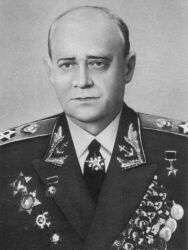Ivan Isakov
Tuesday, February 9, 2021
Ivan Stepanovich Isakov (22 August [O.S. 10 August] 1894 – 11 October 1967), born Hovhannes Ter-Isahakyan, was a Soviet Armenian military commander, Chief of Staff of the Soviet Navy, Deputy USSR Navy Minister, and held the rank of Admiral of the Fleet of the Soviet Union.
He played a crucial role in shaping the Soviet Navy, particularly the Baltic and Black Sea flotillas during the Second World War. Aside from his military career, Isakov became a member and writer of the oceanographic committee of the Soviet Union Academy of Sciences in 1958 and in 1967, became an honorary member of the Armenian Soviet Socialist Republic's Academy of Sciences.
Ivan Isakov was born Hovhannes Ter-Isahakyan in the family of an Armenian railway worker in the village of Hadjikend in the Kars Oblast, then a part of the Russian Empire (currently the Kars vilayet of Turkey). He Russianized his name after Russian Revolution. His father died soon after he was born. Afterward his mother raised their three children with her brother. His uncle had dreamed of service in the navy and had a library of marine literature, which inspired an identical love of watercraft for Isakov. The family later moved to Tiflis, where he studied mathematics and engineering at the local realschule, which Isakov graduated from in 1913.
In 1917, Isakov moved to Petrograd and entered the Naval Guards School of the Imperial Russian Navy and graduated as a midshipman in March of that year. He briefly saw action against the Germans in West Estonian archipelago (Moonsund archipelago). He continued his service after the October Revolution in the Baltic Sea fleet as a torpedo officer, where he served on several warships, including the Izyaslav, the Riga, the Kobchik and the Korshun. In 1918, he took part in several battles against the German Imperial Navy until the signing of the Treaty of Brest-Litovsk, which effectively ended the war between Russia and Germany, granting the Baltic Sea to the latter. In March 1918, Isakov participated in the Ice Cruise of the Baltic Fleet from the naval base at Helsingfors where Russian warships and icebreakers were transferred from the Baltic to the naval base in Kronshtadt near Petrograd. An authoritative Russian Navy source notes that Isakov completed additional courses in mine-sweeping and mine-laying in 1919 and then served in the Caspian Sea, returning to the Baltic in 1920 and subsequently serving in the Black Sea until the mid-1920s.
In 1920, Isakov was transferred and assigned to the destroyer Deyatelni, which patrolled from the Volga River down to the Caspian Sea and later shelled the positions of Allied interventionist forces in the midst of the Russian Civil War. Noted for his distinction during the battles, he was made the gun battery commander of the destroyer Izyaslav in 1921. From 1922 to 1927, he served as a shtab operative, or member of the deputy chief of staff, of naval forces in the Black Sea Fleet. In 1928, Isakov completed academic courses at the Naval Academy in Leningrad and from 1930, he was Chief of Staff of the Baltic Fleet. In 1932, Isakov became the professor and head of the naval art department of the Soviet Naval Military Academy and taught as a professor for five years until he was promoted commander of the Baltic Fleet. From 1938 to 1939, he headed the Naval Academy. Isakov was appointed vice-commissar of naval affairs, and in 1939, he led a naval delegation to the United States with the goal of purchasing new warships. He met with the Secretary of the Navy, but the delegation left empty-handed since the US was unwilling to extend aid to the Soviet Union. Isakov broke away from teaching with the onset of the Winter War and entered active service; he coordinated not only the movement of naval warships in the Baltic Sea but also the ground forces of the Red Army in the Soviet war against Finland. From 1941 to 1943 Isakov was the chief of the Main Maritime Staff. In 1946 to 1947, he was chief of the Main Navy Staff. In 1947 to 1950, he was deputy commander-in-chief of the navy. In 1950 to 1956, he was deputy Naval Minister. From 1957, he was a member of the Defense Ministry General Inspectorate.





